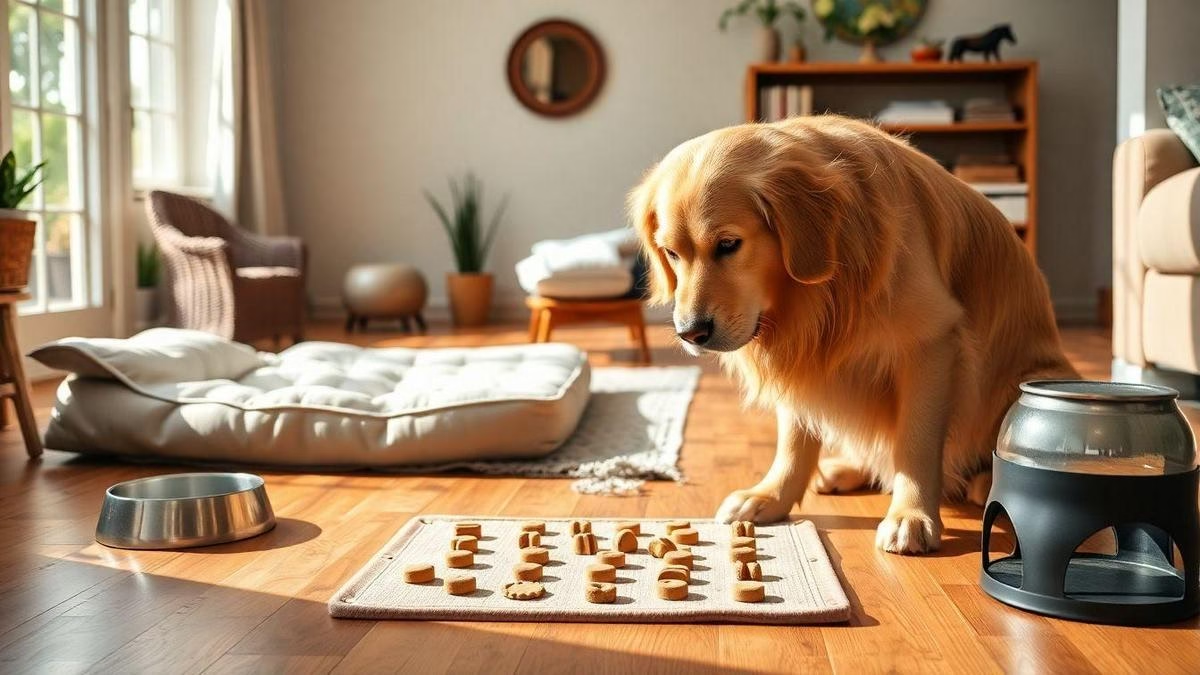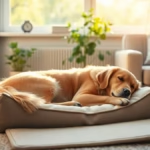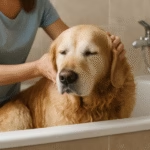Building Daily Enrichment Activities for Senior Golden Retrievers is my guide to gentle, joyful routines for my aging buddy. I share how short routines lift mood and cognition, how I schedule sessions for energy and rest, and my simple morning and evening checklist. I show low-impact exercises like walks, water play, and stretches, plus easy mobility and balance steps to protect hips and knees. I describe quick mental stimulation games, safe scent work, calming sensory moments with massage and soft sound, and how I choose and rotate toys with a tidy cleaning routine to keep everything fresh and fun. For overall structure I follow practical ideas from a few trusted resources on creating a healthy routine for senior Goldens.
Key Takeaway
- I give short gentle walks to keep joints moving.
- I use slow puzzle feeders for easy meals.
- I play scent games to boost the mind.
- I offer soft beds and light massages.
- I adjust activities to match my dog’s energy.
How I build daily enrichment for my senior golden retriever using short routines
I start small and steady. My old Golden tires faster now, so I break the day into short, meaningful moments: sniffing games, soft puzzles, and gentle walks. Short routines keep him alert without wearing him out; even five minutes on a scent trail brings joy.
I watch his signals and adjust the next session—more praise and simple games when he’s bright, gentler options when he slows. Food-dispensing toys, a folded towel with treats, and soft vocal praise give tiny wins—finding a hidden kibble or choosing the right toy—that build confidence and keep his mind working. For new activity ideas I often refer to articles on daily routines senior Goldens appreciate.
After a rough winter when he seemed slow and a bit lost, Building Daily Enrichment Activities for Senior Golden Retrievers became our motto. Now I plan three or four short bursts each day: a calm sniff session after breakfast, gentle play midmorning, a focused puzzle after lunch, and a cozy massage before bed. Those small sparks add up to a happier dog.
Why steady daily enrichment helps mood and cognition
Consistent short activities give my dog rhythm. Instead of one big walk that leaves him tired or bored, a flow of mini-tasks keeps his brain engaged. I notice less pacing, fewer restless whines, and more relaxed naps after a day of varied short sessions.
Enrichment is food for his mind. Simple games—nose work, slow feeding, soft training—keep neurons active and help slow mental decline. He remembers old cues and sometimes picks up tiny new habits. That bright spark in his eyes tells me the work pays off. For focused mental ideas I lean on guides about mental enrichment activities for senior Goldens and practical tips on keeping their minds active.
How I schedule short sessions for energy and rest (daily enrichment for senior golden retrievers)
I plan sessions around natural energy highs and lows. Morning is gentle: short sniff walk or puzzle bowl. Midday can be a playful five-minute soft fetch. Late afternoon is another calm sniff session, and evening is for massage or slow training. Spacing keeps him energized but not drained.
Clear cues help him know what’s coming: a certain blanket means nap time; a soft bell means puzzle time. Predictable signals help him switch between activity and rest without stress. When I stick to short, regular sessions, he stays steadier in mood and sleep. For scheduling templates and simple daily care, I consult suggestions on simple daily care routines for senior Goldens.
| Session | Typical Duration | Main Goal | Example |
|---|---|---|---|
| Sniff work | 5–10 min | Mental stimulation, scent use | Scatter treats on a mat |
| Puzzle feeding | 5–10 min | Slow eating, problem solving | Food-dispensing toy |
| Gentle play | 3–7 min | Light exercise, bonding | Short soft fetch |
| Massage/training | 5–10 min | Calm, touch, cognitive cueing | Sit/stay with gentle stroking |
My simple morning and evening checklist for an enrichment routine
I keep one short checklist I can run through in under five minutes so it becomes habit. Morning items wake him gently; evening items help him wind down.
- Morning sniff mat or scatter breakfast in a towel
- Short 5–8 minute walk at a slow pace
- Quick 3–5 minute obedience or trick with soft praise
- Midday puzzle bowl or stuffed Kong for slow feeding
- Short gentle play session (3–7 minutes) if he’s up for it
- Late afternoon calm sniff or slow stroll
- Evening 5–10 minute massage and light grooming
- Final quiet training cue (like settle) before bed
If you want more structured routine ideas, see tips on creating a healthy routine and daily routines senior Goldens appreciate.
Low-impact exercises I use to keep joints moving in my aging golden
I watch him closely each morning. He moves slower but still loves to sniff and wag. To keep joints moving I mix short, gentle activity with quiet rest—small sessions twice a day instead of one long walk. That rhythm keeps stiffness from setting in.
I focus on movements that feel good: slow walking, light stretches, and gentle water play protect hips and knees while letting him be a dog. If he limps, pants hard, or pulls back, I stop and try a gentler option. My vet guides what to add or skip. For safe, joint-friendly movement ideas, I review resources on low-impact exercises for Goldens with arthritis and safe exercises for senior Goldens.
Building Daily Enrichment Activities for Senior Golden Retrievers is woven into our plan: short games that spark the mind without stressing joints—scent puzzles on the floor, slow food-dispensing toys, or a few seconds of soft tug. Those tiny wins brighten his day and keep him moving.
Gentle walks, water play, and stretching as low-impact exercises
Gentle walks are the backbone. I pick flat routes and go slow—ten to twenty minutes works well; on bad days we do five. Letting him lead the pace and pause to sniff keeps brain and muscles active without wear and tear. For ideas on outdoor options that stay friendly on aging bodies, see outdoor activities seniors can still enjoy.
Water play changed everything when his hips got stiff. A shallow pond or kiddie pool lets him paddle with less weight on his joints. Canine hydrotherapy sessions can be short and powerful; I learned precautions from a guide to hydrotherapy for senior Goldens. After water work, I towel him dry and let him rest in a warm spot.
| Exercise | Why I use it | Typical time/frequency |
|---|---|---|
| Short flat walk | Keeps joints moving, low strain | 10–20 min, 1–2x daily |
| Water paddling | Low weight on hips and knees | 5–15 min, 2–3x weekly |
| Gentle stretching | Maintains range of motion | 3–5 min, after walks |
Mobility and balance exercises I teach to protect hips and knees
I teach balance work slowly, like a new trick. Start with one paw on a low step or cushion and reward each hold. Over weeks, increase hold time by a second or two. That builds tiny muscles around the joints and gives more confidence standing and turning.
Backing up and slow sits build hip control. Backing up strengthens hindquarters safely; slow sits—asking him to sit gradually and hold for a few breaths—help balance. Short sets, three to five reps, are enough. I make it fun with treats and praise so it feels like play, not work. If you want formal examples, see posts on canine physical therapy benefits and gentle exercise routines.
My easy at-home set of balance steps and slow sits
I keep this routine short and simple so he looks forward to it. Warm him with a minute of walking, then gentle balance holds on a cushion, finish with slow sits and a tasty reward.
- Walk warm-up: 2–3 minutes on flat ground
- Cushion holds: paw on soft cushion, hold 3–5 seconds, repeat 6–8 times
- Back-up steps: 3–5 small steps back, repeat 4 times
- Slow sits: ask for a sit slowly over 3 seconds, hold 2–5 seconds, repeat 6 times
- Cool-down sniff time and a gentle rub
Mental stimulation games I play to keep my older retriever sharp
I began Building Daily Enrichment Activities for Senior Golden Retrievers because Buddy slowed down but his nose and brain were still hungry. Short, fun sessions wake him more than long walks. I keep sessions under five minutes, use favorite treats, and mix scent, problem-solving, and simple cues so his mind gets a workout without tiring his body.
Small wins matter: a quick shell game, a sniff trail through the living room, or a slow feeder with hidden kibble gives mental work and a reason to wag. I stop while he’s still happy so he’s excited next time. For more mental game ideas, check resources on keeping the senior mind active and a wider set in mental enrichment activities.
Over months I saw changes: calmer vet visits, remembered cues, and eagerness for game time. Short, steady practice beats marathon sessions for an older golden every time.
Puzzle feeders and interactive toys for slow eating and thought
I use puzzle feeders that force Buddy to work for kibble slowly: simple rotating bowls, snuffle mats, and low-effort treat dispensers. He eats slower, chews gentler, and seems more satisfied. I prefer toys that open wide and don’t require strong jaws, since his teeth and joints are softer now. For guidance on selecting safe items I follow recommendations on appropriate toys to stimulate senior Goldens.
When choosing toys, I look for large pieces and easy access. Rotate toys so each feels new again. Start on the easiest setting and show the trick once, then let him try. A favorite small toy or a highly scented treat inside sparks interest without frustration.
| Toy type | Why I like it | Best for |
|---|---|---|
| Snuffle mat | Uses nose, low movement | Dogs who love sniffing |
| Slow feeder bowl | Slows eating, calming | Fast eaters or digestive issues |
| Simple treat puzzle (large) | Problem-solving, short play | Seniors with limited jaw strength |
Short training drills to reinforce cues and memory
I keep training tiny and fun: five reps of a cue, a treat, and a cheer. “Sit,” “touch,” and “wait” are staples. For memory, I hide a toy under a blanket and ask him to find it. Short drills remind him of old commands and give his brain a lift without tiring his body. I always end on an easy win so he stays confident. For ideas tailored to limited mobility, see gentle training approaches and indoor training games.
I adapt drills to mobility—train from a sit or lie down if standing is hard. Clear hand signals and a calm voice work best for seniors.
My three favorite three-minute brain games to use daily
Three minutes is all you need to make a difference.
- Shell game: hide a treat under one of three cups and let him nose the right cup
- Scent spots: place three tiny treats around a room and tell him to “find” each one
- Blanket search: hide a toy in a blanket pile and ask him to uncover it
Scent work and nose games I practice to spark joy
Watching my golden work a scent trail lights him up. I pick games that use his nose without asking him to run or jump. Short hunts, snuffle mats, and slow-paced searches fit into our day and keep his mind active.
Gentle challenges—treat under a towel, a toy dabbed with chicken broth, or a single scent hidden along the hallway—give purpose and calm. I avoid long sessions and stop before he tires, so the game stays fun.
Building Daily Enrichment Activities for Senior Golden Retrievers helped me see how a few minutes, two or three times a day, complement slow walks and easy stretches.
How I introduce scent work safely and slowly
I check with our vet and watch for stiffness or breathing trouble. Start obvious: treat in plain view, let him sniff, then pick it up and repeat. Keep sessions very short—two to four minutes—and let him set the pace. If he slows or seems unsure, switch to praise and a break.
Watch body language: if he hesitates, lower the challenge and add a visible cue. If he’s excited, add a tiny step up, like hiding the treat behind a low pillow. Slow progression builds confidence and keeps work gentle on joints.
DIY hide-and-seek scent games and safe scent toys for older noses
Use simple items at home: muffin tins, old towels, cardboard boxes, and soft toys. Never use small parts he could swallow. For scents use plain cooked chicken, a pinch of cheese, or a dab of low-sodium broth. Place items at floor level and avoid stairs or high spots.
Step-by-step basic hide-and-seek routine:
- Place a treat on the floor in full view and let him take it. Repeat twice.
- Cover the treat lightly with a towel and encourage him: Find it! Wait and praise when he sniffs and uncovers.
- Move the towel a tiny bit away so he has to nudge it. Reward each success with calm praise.
- If confident, hide treats in different rooms but keep searches short and supervised.
| Item | Scent idea | Best for |
|---|---|---|
| Snuffle mat | Small pieces of chicken | Slower, focused sniffing |
| Muffin tin tennis balls | Cheese bits | Gentle paw use and nose work |
| Soft toy with pouch | Dab of low-sodium broth | Comfort and scent retrieval |
One-step treat hide routine I use to build confidence
Keep it very simple: one treat, one towel, one praise. Show the treat, place it under a towel while he watches, say Find it, and wait. When he uncovers it, make a fuss—happy voice, gentle pet, small walk around the room. Repeating this three times builds confidence fast.
Calming sensory activities I offer to soothe nerves
When my golden slowed and got anxious at night, I started simple sensory routines that soothe: touch, sound, and safe scents. Short, regular moments calm mind and body. Building Daily Enrichment Activities for Senior Golden Retrievers cut his pacing and deepened our bond.
I watch his signals—leaning into my hand means keep going; pulling away means stop. I mix techniques—gentle massage, soft music, a familiar scent on a blanket—so nothing surprises him. Each tool is low-impact and easy to fit into our day. The goal is comfort, not a big training session. For setting up a calm space, I found ideas on creating calm environments and creating comfort for senior Goldens helpful.
Routine matters more than intensity. Five minutes in the morning and five before bed works well. Consistent timing makes him expect calm time, like a lullaby.
Gentle massage, touch, and slow petting to ease arthritis and stress
Use slow, deliberate strokes on shoulders, chest, and hips with warm hands and light pressure. Avoid bony areas or directly over inflamed joints. Slow petting soothes nerves and can relieve muscle tension; after a few minutes he often sighs and relaxes. For technique tips I reference guides on therapeutic massage for senior Goldens.
Pair touch with simple cues: a soft word, a gentle hand, and steady breathing. A folded towel under his hips during massage reduces strain. Little adjustments keep sessions comfortable and build trust.
Using sound and safe scents to create a calm space
Play quiet classical or ambient nature sounds at low volume to drown out jarring noises. Avoid sudden or bright sounds—aim for a steady, gentle backdrop.
For scents, stick to mild, dog-safe options and keep them subtle. Avoid concentrated essential oils and anything with strong citrus or tea tree. A cotton ball with diluted lavender or a chamomile linen spray on his blanket can help—always check his reaction and stop if he seems unsure.
| Scent | How I use it | Caution |
|---|---|---|
| Lavender | One drop on cotton near bed, not on fur | Avoid direct skin contact; watch for sneezing |
| Chamomile | Light spray on blanket | Use sparingly; monitor reactions |
| Vanilla | Faint scent on a toy or cloth | Tiny amount; not a substitute for vet care |
My short calming session with massage and soft music
I dim the lights, play soft music, and sit next to him. Warm my hands, stroke his shoulders, and gently massage for five minutes. Keep voice low. When he yawns or closes his eyes, end with calm praise and a small treat.
- Dim lights and low music
- Warm hands and check for sore spots
- Slow strokes and light massage (5–7 minutes)
- Quiet praise and a small reward
- Soft towel or blanket for rest
Choosing toys and tools I trust for play
I pick toys that match changing body and mind. As she slowed, I switched from fast-chase balls to softer, larger toys she can hold easily. I choose toys that give gentle mental work, like low-effort treat puzzles and scent pads—joy without strain.
Comfort and safety come first: soft textures for sore mouths, firm rubber for gentle chewing, and simple mechanisms to avoid frustration. I watch how she uses each item and retire anything stressful or too hard for her paws and jaw. For shopping and selection guidance see appropriate toys to stimulate senior Goldens.
I keep a toolkit: a lightweight tug with loop handle, low-bounce balls, plush with reinforced seams, and a slow-feeder bowl. Trial-and-error taught me to trust what works for her, not just what’s popular.
What I look for in interactive toys: size, texture, ease
Size first—must be big enough she can’t swallow and easy to grip. Texture and weight matter: soft plush with strong seams for cozy carry, medium-density rubber for chewing without hurting gums. Simpler puzzles with single levels keep frustration low.
| Feature | Why it matters | Example |
|---|---|---|
| Size (med–lg) | Prevents swallowing, easier to grip | Large rubber ball, oversized plush |
| Soft texture | Gentle on gums and teeth | Fleece tug, plush with no hard seams |
| Low complexity | Keeps dog engaged without stress | Single-chamber treat toy, scent pad |
| Light weight | Easier to carry and toss softly | Foam ball, lightweight rope with loop |
How I rotate toys and set an enrichment routine for aging retrievers
I use short sessions—five to fifteen minutes—two or three times daily. One session is physical (slow tosses or gentle tug), another mental (scent work or a simple puzzle). Mixing activity and rest keeps her alert but never worn out. This rhythm helped her sleep better and stay eager for play.
Rotation is simple: keep four to six toys in play and swap every two to four days. When a toy returns, add a treat or a new scent to make it feel fresh. Building Daily Enrichment Activities for Senior Golden Retrievers became easier when I followed that pattern.
My cleaning and rotation checklist to keep toys safe and fresh
I clean toys on a schedule and check them before every session. Toss anything with holes, loose stuffing, or big bite marks. Separate indoor and outdoor toys and dry everything fully before storing.
- Inspect toy for tears, loose parts, or mold before use
- Wash plush toys weekly in hot water and air dry; scrub rubber toys after heavy use
- Sanitize chew toys monthly with pet-safe cleaner or diluted vinegar solution
- Retire toys with holes or exposed stuffing immediately
- Store toys in a dry bin and rotate every 2–4 days
Quick tips — Building Daily Enrichment Activities for Senior Golden Retrievers (practical reminders)
- Keep sessions short (3–10 minutes) and frequent.
- Let your dog set the pace—stop while he’s engaged.
- Prioritize low-impact movement and mental tasks.
- Rotate toys and scents to renew interest.
- Check with your vet before adding new physical activities. For further daily support ideas see gentle daily activities to support senior well-being.
Conclusion
I learned that small, consistent moments beat marathon sessions. Short routines—sniff mats, gentle walks, tiny brain games—become the sparks that lift mood and sharpen cognition. I watch his body and eyes, adjust, and stop when he’s had enough.
Keeping things low-impact and predictable protects joints and builds confidence. Simple mobility steps, slow scent work, and a cozy calming routine are like a warm blanket over his day. Mix comfort and challenge; keep wins easy so he stays eager and proud.
My checklist and toy rotation keep our days tidy and fun. Clean, safe toys and short, purposeful sessions create steady progress. The bond we’ve rebuilt is the best payoff. Small ripples, not big waves, make the golden years gentle and joyful.
If you want more tips and ideas, read more articles at Top Curiosities or explore related posts like building stronger bonds with your senior Golden and real-life inspiration in real stories of thriving senior Goldens.

Rafael Souza is a digital marketing strategist and lifelong dog enthusiast. Passionate about Golden Retrievers, he shares practical, research-based tips to help owners provide healthier and happier lives for their furry companions.





